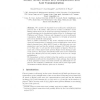Free Online Productivity Tools
i2Speak
i2Symbol
i2OCR
iTex2Img
iWeb2Print
iWeb2Shot
i2Type
iPdf2Split
iPdf2Merge
i2Bopomofo
i2Arabic
i2Style
i2Image
i2PDF
iLatex2Rtf
Sci2ools
EUROCRYPT
2007
Springer
2007
Springer
Atomic Secure Multi-party Multiplication with Low Communication
We consider the standard secure multi-party multiplication protocol due to M. Rabin. This protocol is based on Shamir’s secret sharing scheme and it can be viewed as a practical variation on one of the central techniques in the foundational results of Ben-Or, Goldwasser, and Wigderson and Chaum, Cr´epeau, and Damgaard on secure multi-party computation. Rabin’s idea is a key ingredient to virtually all practical protocols in threshold cryptography. Given a passive t-adversary in the secure channels model with synchronous communication, for example, secure multiplication of two secretshared elements from a finite field K based on this idea uses one communication round and has the network exchange O(n2 ) field elements, if t = Θ(n) and t < n/2 and if n is the number of players. This is because each of O(n) players must perform Shamir secret sharing as part of the protocol. This paper demonstrates that under a few restrictions much more efficient protocols are possible; even at...
Cryptography | EUROCRYPT 2007 | Rabin’s Idea | Secure Multi-party Multiplication | Secure Multiplication |
| Added | 07 Jun 2010 |
| Updated | 07 Jun 2010 |
| Type | Conference |
| Year | 2007 |
| Where | EUROCRYPT |
| Authors | Ronald Cramer, Ivan Damgård, Robbert de Haan |
Comments (0)

